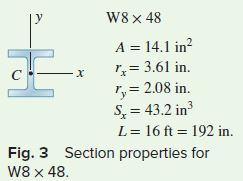Question 10.SP.7: A steel column with an effective length of 16 ft is loaded e......
A steel column with an effective length of 16 ft is loaded eccentrically as shown. Using the interaction method, select the wide-flange shape of 8-in. nominal depth that should be used. Assume E=29 \times 10^6 \text { psi and } \sigma_Y=36 ksi, and use an allowable stress in bending of 22 ksi.
STRATEGY: It is necessary to select the lightest column that satisfies Eq. (l0.57). This involves a trial-and-error process, which can be shortened if the first 8-in. wide-flange shape selected is close to the final solution. This is done by using the allowable-stress method, Eq. (10.55), with an approximate allowable stress.
\frac{P}{A}+\frac{M c}{I} \leq \sigma_{\text {all }} (10.55)
\frac{P / A}{\left(\sigma_{\text {all }}\right)_{\text {centric }}}+\frac{M c / I}{\left(\sigma_{\text {all }}\right)_{\text {bending }}} \leq 1 (10.57)

Learn more on how do we answer questions.
MODELING and ANALYSIS:
So that we can select a trial section, we use the allowable-stress method with \sigma_{\text {all }}=22 ksi and write
\sigma_{\text {all }}=\frac{P}{A}+\frac{M c}{I_x}=\frac{P}{A}+\frac{M c}{A r_x^2} (1)
From Appendix E, we observe that for shapes of 8-in. nominal depth c \approx 4 \text { in. and } r_x \approx 3.5 \text { in } . Using Fig. 1 and substituting into Eq. (1),
22 ksi =\frac{85 kips }{A}+\frac{(425 kip \cdot in .)(4 \text { in. })}{A(3.5 in .)^2} \quad A \approx 10.2 in ^2
For a first trial shape, select W8 × 35.
Trial 1: W8 × 35 (Fig. 2). The allowable stresses are
Allowable Bending Stress: (see data) \left(\sigma_{\text {all }}\right)_{\text {bending }}=22 ksi
Allowable Concentric Stress: The largest slenderness ratio of the column is L / r_y = (192 in.)∕(2.03 in.) = 94.6. Using Eq. (10.41) with E=29 \times 10^6 psi \text { and } \sigma_Y=36 ksi, the slenderness ratio at the junction between the two equations for \sigma_{ cr } \text { is } L / r = 133.7. Thus, use Eqs. (10.38) and (10.39) and find \sigma_{ cr }=22.5 ksi. Using Eq. (10.42), the allowable stress is
\sigma_{ cr }=\left[0.658^{\left(\sigma_\gamma / \sigma_c\right)}\right] \sigma_Y (10.38)
\sigma_e=\frac{\pi^2 E}{(L / r)^2} (10.39)
\frac{L}{r}=4.71 \sqrt{\frac{E}{\sigma_Y}} (10.41)
\sigma_{ all }=\frac{\sigma_{ cr }}{1.67} (10.42)
\left(\sigma_{\text {all }}\right)_{\text {centric }}=22.5 / 1.67=13.46 ksi
For the W8 × 35 trial shape,
\frac{P}{A}=\frac{85 kips }{10.3 in ^2}=8.25 ksi \quad \frac{M c}{I}=\frac{M}{S_x}=\frac{425 kip \cdot in .}{31.2 in ^3}=13.62 ksi
With this data, the left-hand member of Eq. (10.57) is
\frac{P / A}{\left(\sigma_{\text {all }}\right)_{\text {centric }}}+\frac{M c / I}{\left(\sigma_{\text {all }}\right)_{\text {bending }}}=\frac{8.25 ksi }{13.46 ksi }+\frac{13.62 ksi }{22 ksi }=1.232
Since 1.232 > 1.000, the requirement expressed by the interaction formula is not satisfied. Select a larger trial shape.
Trial 2: W8 × 48 (Fig. 3). Following the procedure used in trial 1 gives
\begin{gathered} \frac{L}{r_y}=\frac{192 in. }{2.08 in. }=92.3 \quad\left(\sigma_{\text {all }}\right)_{\text {centric }}=13.76 ksi \\ \frac{P}{A}=\frac{85 kips }{14.1 in ^2}=6.03 ksi \quad \frac{M c}{I}=\frac{M}{S_x}=\frac{425 kip \cdot in .}{43.2 in ^3}=9.84 ksi \end{gathered}
Substituting into Eq. (10.57) gives
\frac{P / A}{\left(\sigma_{\text {all }}\right)_{\text {centric }}}+\frac{M c / I}{\left(\sigma_{\text {all }}\right)_{\text {bending }}}=\frac{6.03 ksi }{13.76 ksi }+\frac{9.82 ksi }{22 ksi }=0.885<1.000
The W8 × 48 shape is satisfactory but may be unnecessarily large.
Trial 3: W8 × 40 (Fig. 4). Following the same procedure, the interaction formula is not satisfied.
Selection of Shape. The shape to be used is W8 × 48



